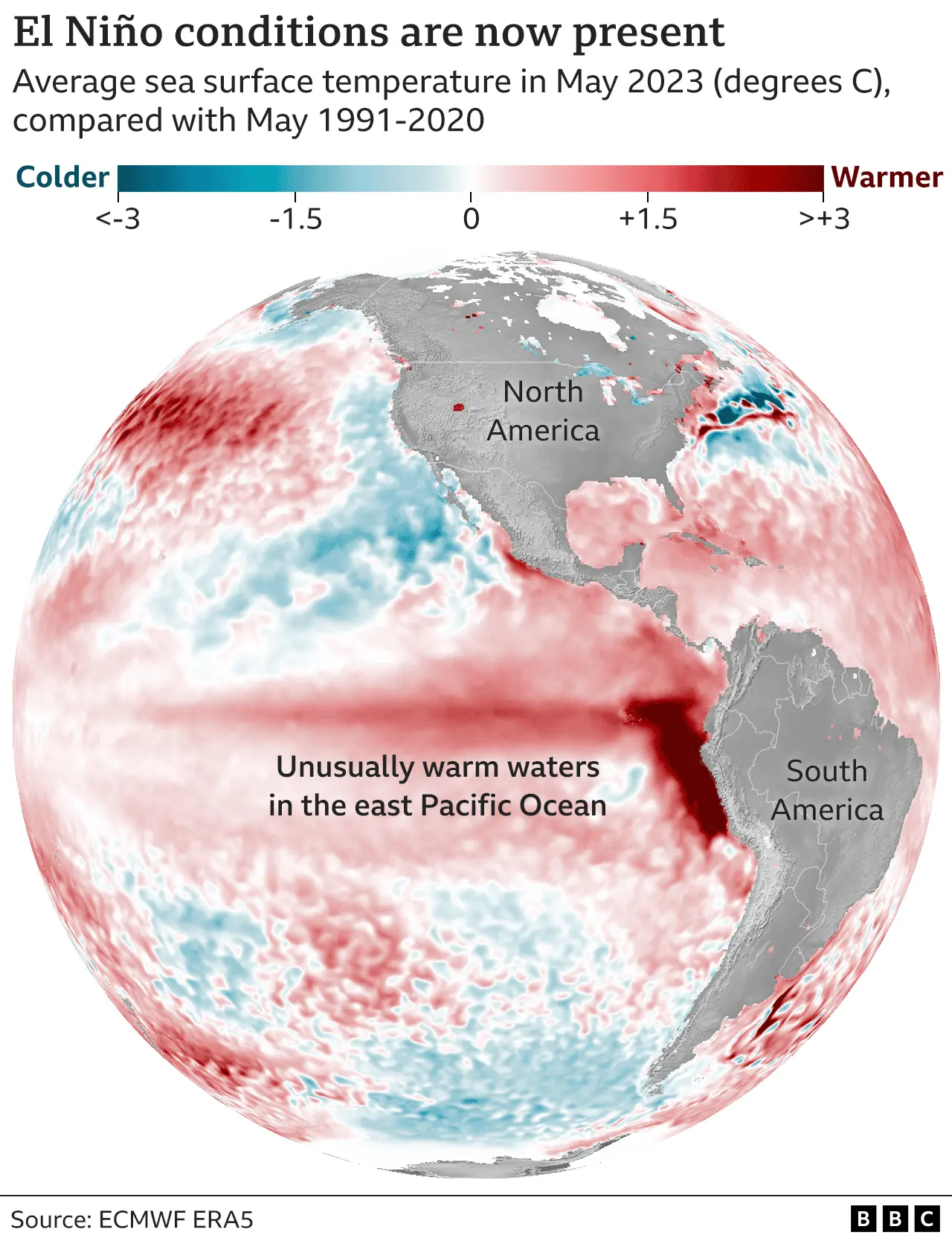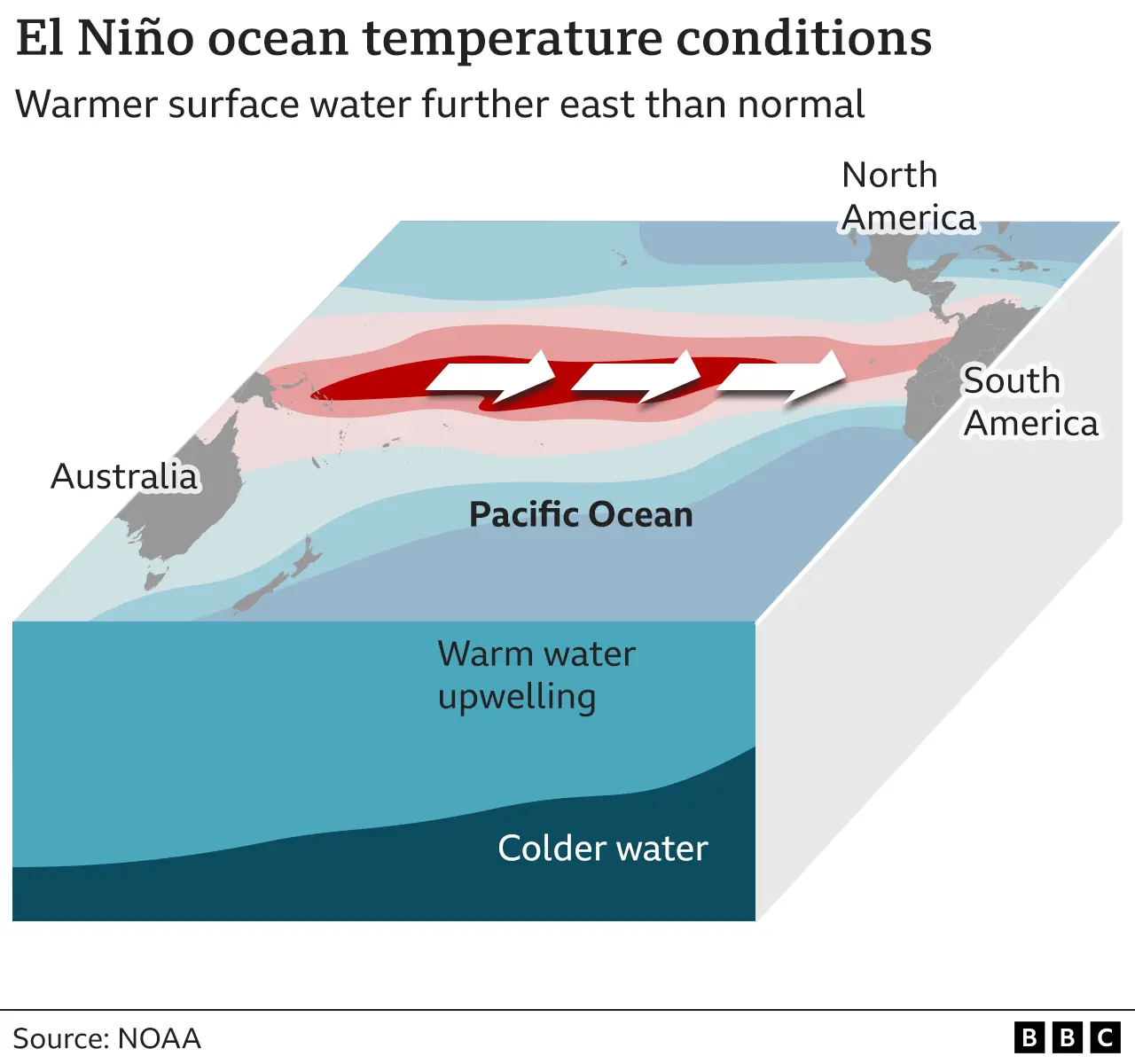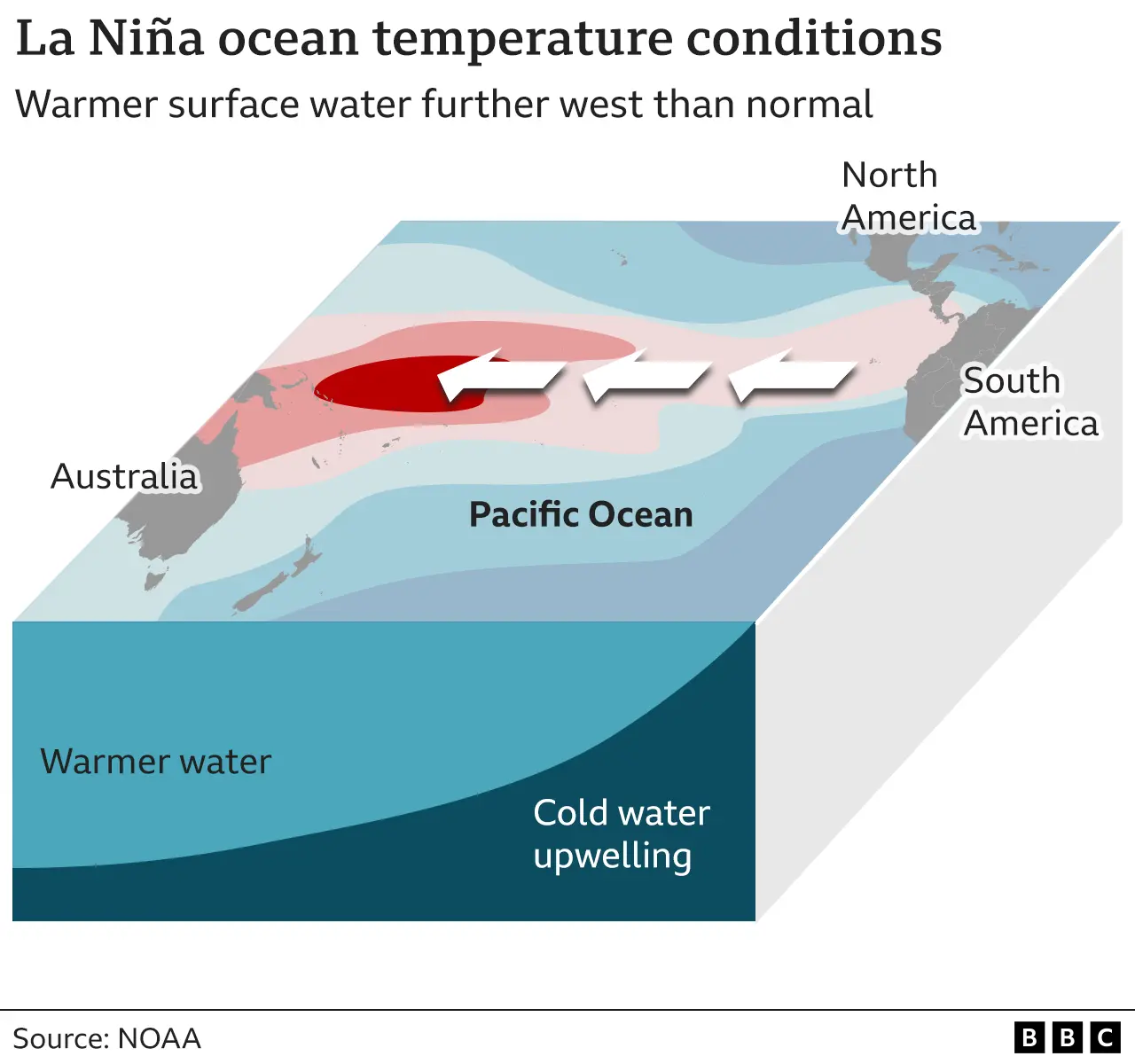The world has officially entered an El Niño phase, according to the US science agency NOAA.Scientists believe the weather patterns typically seen during El Niño are likely to send global temperatures soaring to record levels in the next few years.
El Niño is part of the natural climate phenomenon called the El Niño Southern Oscillation (ENSO).
It has two opposite states - El Niño and La Niña -
both of which significantly alter global weather.An El Niño event is typically declared when sea surface temperatures in the tropical eastern Pacific rise to at least 0.5C above the long-term average.
| El Niño | La Niña |

| 
|
Not every ENSO event is the same, and the consequences vary from region to region. However, scientists have observed some common effects:
1. Temperatures
2. Changes to rainfall
3. Tropical storms
4. Carbon dioxide (CO2) levels
The extreme weather events caused by El Niño and La Niña affect infrastructure, food and energy systems around the world.
----
What are El Niño and La Niña?El Niño and La Niña are climate patterns in the Pacific Ocean that can affect weather worldwide. During normal conditions in the Pacific ocean, trade winds blow west along the equator, taking warm water from South America towards Asia. To replace that warm water, cold water rises from the depths — a process called upwelling. El Niño and La Niña are two opposing climate patterns that break these normal conditions. Scientists call these phenomena the El Niño-Southern Oscillation (ENSO) cycle. El Niño and La Niña can both have global impacts on weather, wildfires, ecosystems, and economies. Episodes of El Niño and La Niña typically last nine to 12 months, but can sometimes last for years.
El Niño and La Niña events occur every two to seven years, on average, but they don’t occur on a regular schedule. Generally, El Niño occurs more frequently than La Niña.
----
Emphasis mine. This is a natural oscillation that I was alluding to. The world is shifting from La Nina to El Niño in current times. This shift is responsible for numerous weather extremes around the world lately. Now I understand why my region witnessed record levels of rainfall this year.
Eco-alarmists begrudgingly admitting the obvious:
Scientists have warned that 2024 could mark the year when global warming exceeds 1.5℃ above pre-industrial levels. They attribute these predictions, at least in part, to the emergence of an El Niño event.
An El Niño is declared when the sea surface temperature in large parts of the central or eastern equatorial regions of the Pacific Ocean warms significantly – sometimes by as much as 2℃. This additional heat in turn warms the atmosphere. During El Niño years, this warming contributes to a temporary rise in the global temperature by a fraction of a degree.
El Niño primarily affects weather in the tropics. Intense downpours that would usually fall on parts of south-east Asia or eastern Australia instead fall on the west coast of South America. This change can cause major drought and flooding on different continents, affecting food production and even weather-dependent sports like cricket.
But changes to the weather in these regions can have knock-on effects all over the world. Even thousands of kilometres away in northern Europe, El Niño tends to cause colder and drier winter weather.
Yet many factors affect European weather, especially during winter. So care is needed when linking unusual weather events in Europe to El Niño.Most amusing...
WE are trying to curb harmful practices.
1. Montreal Protocol
Montreal Protocol is hailed as a success story for addressing the alleged problem of ozone depletion but new claims have surfaced in following studies:
Dr. Paul Young is skeptical of the findings of Lu 2022 in particular:
Dr. Paul Young, an atmospheric scientist at Lancaster University and a lead author of the 2022 WMO/UNEP Scientific Assessment of Ozone Depletion, brushed off the new research.
“There is no ‘tropical ozone hole’, driven by the author’s proposed electrons from cosmic rays or otherwise,” he said. “The long term changes and year-to-year variability of the ozone layer in the tropical lower stratosphere (~15-20 km up) are well understood to be the result of both human-driven processes and natural drivers.”Further critic of strictly anthropogenic causes of ozone depletion is mentioned below:
The international treaty to protect the ozone layer turns 20 this year. But is there really much reason to celebrate?
Environmentalists have made numerous apocalyptic predictions over the past several decades, virtually none of which has come to pass. Yet each time, the greens and their political allies proclaim victory, arguing that their preventive prescriptions averted disaster.
Such is the case with the 1987 Montreal Protocol On Substances That Deplete The Ozone Layer (Montreal Protocol). The lurid predictions of ozone depletion-induced skin cancer epidemics, ecosystem destruction and others haven't come true, for which Montreal Protocol proponents congratulate themselves. But in retrospect, the evidence shows that ozone depletion was an exaggerated threat in the first place. As the treaty parties return to Montreal for their 20th anniversary meeting it should be cause for reflection, not celebration, especially for those who hope to repeat this "success story" in the context of global warming.
The treaty came about over legitimate but overstated concerns that chlorofluorocarbons (CFCs, a then-widely used class of refrigerants) and other compounds were rising to the stratosphere and destroying ozone molecules. These molecules, collectively known as the ozone layer, shield the earth from excessive ultraviolet-B radiation (UVB) from the sun. The Montreal Protocol's provisions were tightened in 1990 and again in 1992, culminating with a CFC ban in most developed nations by 1996.
So what do we know now? As far as ozone depletion is concerned, the thinning of the ozone layer that occurred throughout the 1980s apparently stopped in the early 1990s, too soon to credit the Montreal Protocol. A 1998 World Meteorological Organization (WMO) report said that, "since 1991, the linear [downward] trend observed during the 1980s has not continued, but rather total column ozone has been almost constant …" However, the same report noted that the stratospheric concentrations of the offending compounds were still increasing through 1998. This lends credence to the skeptical view, widely derided at the time of the Montreal Protocol, that natural variations better explain the fluctuations in the global ozone layer.
More importantly, the feared increase in ground level UVB radiation has also failed to materialize. Keep in mind that ozone depletion, in and of itself, doesn't really harm human health or the environment. It's the concern that an eroded ozone layer will allow more of the sun's damaging UVB rays to reach the earth that led to the Montreal Protocol. But WMO concedes that no statistically significant long-term trends have been detected, noting earlier this year that "outside the polar regions, ozone depletion has been relatively small, hence, in many places, increases in UV due to this depletion are difficult to separate from the increases caused by other factors, such as changes in cloud and aerosol." In short, the impact of ozone depletion on UVB over populated regions is so small that it's hard to detect.
Needless to say, if UVB hasn't gone up, then the fears of increased UVB-induced harm are unfounded. Indeed, the much-hyped acceleration in skin cancer rates hasn't been documented. U.S. National Cancer Institute statistics show that malignant melanoma incidence and mortality, which had been undergoing a long-term increase that predates ozone depletion, has actually been leveling off during the putative ozone crisis.
Further, no ecosystem or species was ever shown to be seriously harmed by ozone depletion. This is true even in Antarctica, where the largest seasonal ozone losses, the so-called Antarctic ozone hole, occur annually. Also forgotten is a long list of truly ridiculous claims, such as the one from Al Gore's 1992 book "Earth in the Balance" that, thanks to the Antarctic ozone hole, "hunters now report finding blind rabbits; fisherman catch blind salmon."
Overall, the Montreal Protocol isn't making these bad consequences go away -- they were never occurring in the first place.
The parallels with global warming are striking. Again we face a real but greatly overhyped environmental problem. In both cases, virtually everything the public has been told that sounds terrifying isn't true -- and what is true isn't particularly terrifying. But doomsayers such as Gore simply soldier on. His claims of blind animals from ozone depletion have been replaced by equally dubious assertions in his book "An Inconvenient Truth," including predictions of a massive sea level rise that would wipe away south Florida and other coastal areas.
Perhaps decades from now, participants in the Kyoto Protocol, the global-warming treaty modeled after the Montreal Protocol, will meet and congratulate themselves because none of their scary assertions came true. But how many resources will have been spent to save a world that never really needed saving in the first place?
There is a need to understand ozone characteristics on a long-term basis.
2. Global tree plantation drives
Emphasis mine. Global tree plantation drives is an experiment that will affect deserts, beneficial transportation of dust, and climatic conditions.
Saharan dust transport is a valuable case study:
A Dusty Past
“From ground observations and satellite observations, we see African dust variability,” said Tianle Yuan, atmospheric scientist at NASA's Goddard Space Flight Center in Greenbelt, Maryland. “In fact, it can change quite a bit, from month to month, day to day, year to year, even decade to decade.”
Recent dust estimates are derived from data collected by NASA satellite missions, including Terra, Aqua, and Cloud-Aerosol Lidar and Infrared Pathfinder Satellite Observation (CALIPSO), a joint mission between NASA and the French space agency, Centre National d'Etudes Spatiales.
The researchers were also interested in seeing if the relationship between global average temperature and Saharan dust activity occurred in the past. Geological records going back thousands of years help reveal past precipitation and nutrient levels as the Sahara went through dramatic environmental shifts.
The peak of Saharan dust transport to the eastern side of the Americas took place roughly between 12,000 to 17,000 years ago, at the end of the last Ice Age. Then began the African Humid Period, during which the vast expanse of desert was speckled with lakes, vegetation and human habitation. The increased moisture and plant-life stabilized the ground and minimized dust plumes.
“The Sahara Desert was relatively wet back then,” said Yuan. North African sediment cores off the coast and pollen records show that there was more rainfall and vegetation present. “Dust was much rarer.”
Though dust transport has increased since then, the research team found that both natural processes and human activity are now likely driving Earth back toward a dust minimum as climate warms.
Sea surface temperatures directly impact wind speeds, so when the northern Atlantic warms relative to the south Atlantic, the trade winds that blow the dust from east to west become weaker. As a result, the slower winds pick up and transport less dust from the Sahara.
In addition to carrying less dust, the weakened winds also allow the band of steady rain that traverses the tropics to drift north over more of the desert, which dampens the dust and keeps it from getting swept away. Less dust in the air, which can reflect sunshine away from Earth’s surface like a sunshield, means more sunlight and heat reach the ocean, warming it further. All together this creates a feedback loop of warm sea surface temperatures leading to reduced dust, and reduced dust in turn contributing to additional warming, combining to impact climate, air quality, and storm and hurricane formation.
From Dust to Dust Impacts
“Dust plays a major role in the Earth system,” said Hongbin Yu, an atmospheric researcher at Goddard. “A decrease of dust as the climate warms may have profound influences on a variety of phenomena, but these potential impacts may be good or bad.”
On its journey across the Atlantic, Saharan dust sprinkles into the ocean, feeding the marine life, and similarly plant life once it makes landfall. Minerals like iron and phosphorus in the dust act as a fertilizer for the Amazon rainforest, Earth’s largest and most biodiverse tropical forest. Rains wash many of these valuable nutrients from the soil into the Amazon river basin, making the nutrient delivery from Africa important for maintaining healthy vegetation.
Though African dust transport plays an important role in the genesis of soils and sustaining vegetation, Yu says there are some negative effects because the increase in nutrients can lead to harmful algal blooms off the coast of Florida, and coral reef sicknesses and death linked to dust deposition.
Residents in the Caribbean could also see some benefits as less dust means better air quality. Breathing in dust is particularly hazardous for children, the elderly, and those with respiratory conditions such as asthma. That led a team from NASA Earth Applied Sciences Program to develop an early-warning system for Puerto Rico that now provide three days of lead time before a Saharan dust storm reaches the island, giving doctors and public health officials time to prepare and work with meteorologists on air quality alerts. They use data from the Moderate Resolution Imaging Spectroradiometers (MODIS) on NASA's Terra and Aqua satellites, the Advanced Baseline Imager (ABI) instrument aboard the National Oceanic and Atmospheric Administration (NOAA) Geostationary Operational Environmental Satellite (GOES-16 EAST), and the Visible Infrared Imaging Radiometer Suite (VIIRS) on the joint NASA/NOAA Suomi NPP satellite were employed to help detect the advancing Saharan dust plume before it reached islands like Puerto Rico this past year, so that at-risk communities could prepare for the potentially adverse health effects.
3. Electric revolution
Challenges discussed in following link:
4. Bioenergy and C02 capture experiments
----
There are no easy fixes for climatic shifts. WE can do our best to control harmful industrial practices but WE cannot address natural oscillations.
Tectonic activity is also a driver of climate change. What can WE do about this?
A chunk of Africa is found to be splitting due to tectonic activity. What can be WE do about this? Interfere with this process?
Those who think that humans are responsible for everything extreme on Earth, those who do not believe in external factors and forces - this is absolutely questionable line-of-thought.
WE can emphasize better industrial practices and look for solutions to minimize anthropogenic CO2 emissions and even develop technologies to absorb CO2 emissions, but Eco-alarmists need to simmer down.
It is important to understand how the world works and past drivers of extinction. Paleontological findings seem to indicate that extinction is a fate that can befall any complex species and a driver of change in itself. This is the natural order of things. The world has its ways to get rid of even well-established lifeforms.
WE can strive for sustainability but WE do not control everything and our experiments have consequences and affects in general, not just C02 emissions. This might be how things were supposed to be. Pros and Cons; Strengths and Weaknesses; Perfections and Imperfections; Actions and Reactions. The world is like a sandbox that grants freedom to do things but it has surprises of its own.